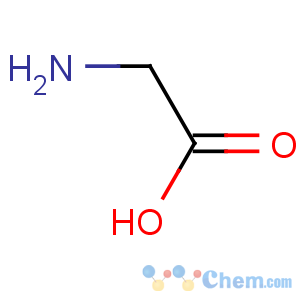Title: Glycine
CAS Registry Number: 56-40-6
Synonyms: Gly; G; aminoacetic acid; aminoethanoic acid; glycocoll
Trademarks: Gyn-Hydralin (Lefrancq)
Molecular Formula: C2H5NO2
Molecular Weight: 75.07
Percent Composition: C 32.00%, H 6.71%, N 18.66%, O 42.63%
Literature References: Non-essential amino acid for human development. Only amino acid with no asymmetric carbon. Major inhibitory neurotransmitter. Isoln from gelatin: H. Braconnot,
Ann. Chim. Phys. 13, 113 (1820). Early chemistry and biochemistry:
Amino Acids and Proteins, D. M. Greenberg, Ed. (Charles C. Thomas, Springfield, IL, 1951) 950 pp.,
passim; J. P. Greenstein, M. Winitz,
Chemistry of the Amino Acids vols 1-3, (John Wiley and Sons, Inc., New York, 1961) pp. 1955-1970,
passim. Exists in three polymorphic forms, a-, b-, and g-: Y. Iitaka,
Nature 183, 390 (1959). Review of metabolism and radioprotection: S. Capalna,
Rev. Roum. Physiol. 9, 17-34 (1972); of metabolism in humans: A. A. Jackson, M. H. Golden,
Clin. Sci. 58, 517-522 (1980); in anerobes: J. R. Andreesen,
Antonie van Leeuwenhoek 66, 223-227 (1994). Review of role in neurotransmission: S. M. Paul in
Psychopharmacolo
gy: The Fourth Generation of Progress, F. E. Bloom, D. J. Kupfer, Eds. (Raven Press, New York, 1995) pp 87-94.
Book: Glycine Neurotransmission, O. P. Ottersen, J. Storm-Mathisen, Eds. (John Wiley & Sons, Chichester, U.K., 1990) pp 489.
Properties: Sweet, monoclinic prisms from alc, starts to dec at 233°, completely sintered at 290°. d 1.1607. pK1 2.34; pK2 9.60. pH of 0.2 molar soln in H2O = 4.0. Adsorption on various chromatographic agents: Grettie, Williams,
J. Am. Chem. Soc. 50, 671 (1928). Soly in 100 ml water at 25°: 25.0 g; at 50°: 39.1 g; at 75°: 54.4 g; at 100°: 67.2 g. 100 g of abs alc dissolve about 0.06 g. Sol in 164 parts pyridine. Almost insol in ether.
pKa: pK1 2.34; pK2 9.60
Density: d 1.1607
Derivative Type: Hydrochloride
Molecular Formula: C2H5NO2.HCl
Molecular Weight: 111.53
Percent Composition: C 21.54%, H 5.42%, N 12.56%, O 28.69%, Cl 31.79%
Properties: Hygroscopic prisms from HCl, mp 182°.
Melting point: mp 182°

